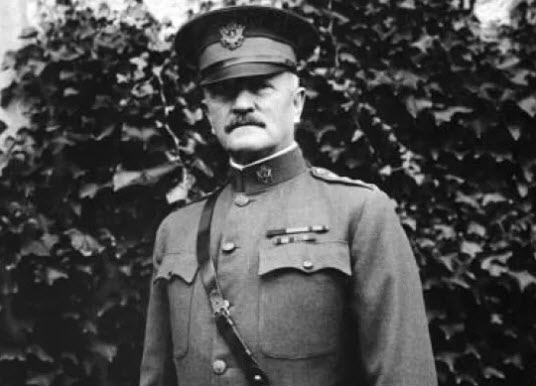Weekly Bookmarks
79th Edition – August 9, 2020
When I’m at bat, I’m in scoring position.
Former Major League Baseball Player, Oscar Gamble
1. Nailing the Financial Narrative
When General John Pershing decided to turn his war diaries into a memoir, he asked his aide, Dwight Eisenhower, for help. Ike wanted the casual reader to understand the war maneuvers and suggested that Pershing use a narrative form when compiling the memoir.
Pershing decided against Ike’s written examples which were easier to read and understand. In the end, Pershing’s published work made little impact, and Ike knew that would be the case.
We live in a world of abstract facts like Pershing’s war diary entries. To say we need to be great at creating financial narratives is an understatement. The best way to learn is to be observant – listen and watch our readers absorb our raw facts that we’ve tried to turn into meaningful information. Let their follow-up questions be the raw material for becoming better at the financial and analytical narrative.

2. Learning Through the Case Method
Speaking of Ike, early in his military career, he attended the Command and General Staff School for one year where teaching was done using the case method. If you went to MBA school, you know exactly how the case method works.
I love reading case studies, and I’ve purchased more than 20 of them through HBR’s website and I just bought another this weekend. If this idea intrigues you, here are some starting points:
- 14 of the Most Important Case Studies
- What are the Best HBS Case Studies? (There are some amazing answers in this thread)
- 7 Favorite Business Case Studies to Teach – and Why
In a similar vein, case interview questions are fun to study too, the type used by the big consulting firms such as McKinsey, BCG, and others. Books like The Ultimate Case Interview Workbook and the last edition of Case in Point are more than fascinating.
My favorite aspect of case studies is that they teach us how to think. One other suggestion if you lead or manage a team is to pick a case study quarterly and do a long lunch with the group and go over findings. Have your team prepare by working in pairs before the meeting.

3. Can a Financial Analyst Become CEO?
I used to write regularly on the Quora platform to practice my writing where I have nearly 5 million views on my answers. The jury is still out on whether my tactic worked.
I still answer a question occasionally, and I bit on the one above if financial analysts can become CEOs.
Anyone can become a CEO. A LinkedIn study a few years ago revealed that computer science was the top field of study for CEOs which I question. Economics was in second place followed by Business.
I started my answer with the first person coming to mind who became the CEO of Litton Industries thanks to his work on a number of acquisitions that worked out well for shareholders.
His name was Tex Thornton, and he upgraded the Army’s Stat Control with numerous Harvard MBAs during World War II. Tex marketed himself and nine others to Ford after the war, and the 10 became known as The Whiz Kids (Ford insiders first called them the Quiz Kids).
But Tex was a business-minded person first who had remarkable skills in math, statistics, and logistics. The best answer is than anyone from any field can become CEO. He or she just needs to be well-versed in all aspects of business and knowing how to assemble great teams to achieve extraordinary outcomes.
Do you agree?
4. Peculiar Business Titles
This past week while heading to Kansas City, my eyes were drawn to an accident along I-70 near a deep ravine where a large semi was lying on its side near roughly 50 yards of a mangled guardrail. First responders were still enroute to the scene.
When we pass accidents such as these, what happens? Yeah, we look. Everyone does.
I did the same thing this week when looking at someone’s book list which included a second and third glance on one of his titles – Everything I Know About Business I Learned from the Grateful Dead: The Ten Most Innovative Lessons from a Long, Strange Trip.
I’m far from a Dead Head (fan), but I think I might have to sneak this book on my reading later this year.

5. The Right Answer
If you choose an answer to this question at random, what is the chance that you will be correct?
A – 25%
B – 0%
C – 50%
D – 25%
That’s a tough question without an easy answer. If you pick 25% (letter A or letter D), are you certain?
That’s why I love our work. Questions and problems might be hard, but there is rarely one right answer. Sometimes, our solutions fall under the categories of good, better, or best. But we never know what’s best till we’ve achieved a good solution and iterate to better outcomes.
What if our solutions miss the mark entirely? Keep doing what you have been. Learn from the mistakes, fix what’s broken, and keep moving forward.
Personal Bookmark
Know someone who has read The Alice Network? If they need a rebound book, suggest Laura Hillenbrand’s, Unbroken. One story is fiction, the other is real. But two central figures were broken physically, mentally, and emotionally by a war that enslaved them. One could not forgive, the other did. When I think I’m having a bad day, I only need to think of the brutality that Gardner and Zamperini endured daily.

Recent Bookmarks – 78 |77 | 76
Thank You For Reading. Thank you for making this a successful newsletter.
If you like the content above and the posts at CFO Bookshelf, may I ask a favor? Feel free to share this with other readers along with commenting on your favorite blog posts on LinkedIn, Twitter, or Facebook.
Always be learning.

Leave a Reply